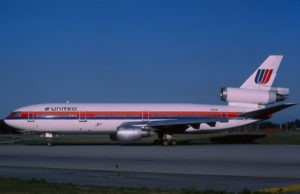
Photo: DavidCB
N1819U McDonnell Douglas DC-10-10 United Airlines
What happens if the pilot loses complete control of the aircraft?
This week’s question comes from Herbert Garrison. I assume he meant the total failure of the control wheel or control column, a device to physically fly the plane. On the modern Airbus, we refer to it as the ‘side stick’.
A control wheel failure on an airliner is a very serious emergency as it renders the elevator and aileron useless – in another words, the pilot is not able to climb, descent or turn the plane conventionally. However, not all is lost as it is still possible to handle the plane by unconventional means.
Instead of pushing the control column down to descent or pulling it up to climb, the pilot uses the thrust levers. When power is applied, the plane climbs and when thrust is reduced, the aircraft descends.
With the loss of ailerons to turn the plane, the captain has to make use of the left or right engine. To turn left, the captain adds more thrust on the right engine or reduces power on the left engine. Juggling minor turns are difficult, especially to align the plane onto the runway.
This happened in a United Airlines DC-10 incident at Sioux City, Iowa in July 1989 where its tail-mounted engine exploded in flight damaging the 3 hydraulic systems. All the flight controls of the plane were lost.
Although there was no specific guide to support such an emergency, Captain Al Haynes and his crew were able to handle these very difficult maneuvers.
Thankfully, they were assisted by an off-duty DC-10 instructor, Captain Dennis Fitch on board. He had studied the case of the Boeing 747 JAL Flight 123 which had suffered a similar loss of all controls on a flight out of Haneda Airport in Japan on 12 August 1985.
In Captain Al Haynes’ flight, he controlled the flight with power from the 2 remaining engines. The plane touched down at high speed but unfortunately, the right wing contacted the ground first, causing it to break apart. 185 out of the 296 people on board survived the crash
There was another similar accident which involved a DHL Airbus A300 in Baghdad back in 2003. This cargo plane was hit on the left wing by a missile, damaging the three hydraulic systems. It left the crew without any conventional flight controls.
However, they successfully maneuvered the plane back to Baghdad Airport and landed safely with nothing more than using asymmetric thrust for heading control and power manipulation for height adjustment.
The 2 incidents above involved planes of the older generations but newer airliners have better redundancies and technology to overcome such problems.
If the both the flight controls are jammed but the hydraulic systems are fine, then it is possible to land the plane by using the auto-pilot.
As such, the captain need not have to manually move the flight controls as an auto-land can bring the plane safely onto the runway with an instrument landing system.
The Impossible Landing – United Airlines Flight 232